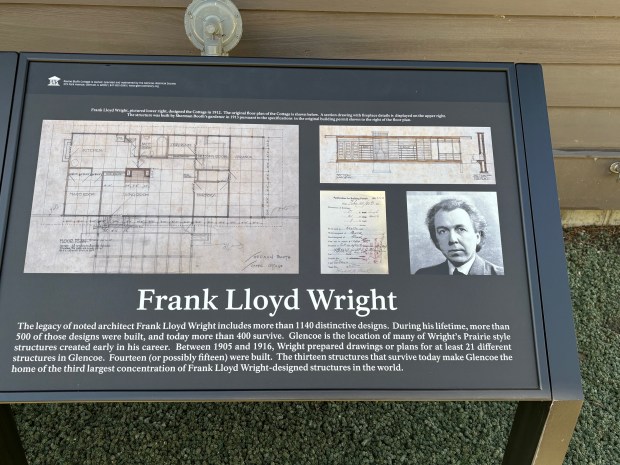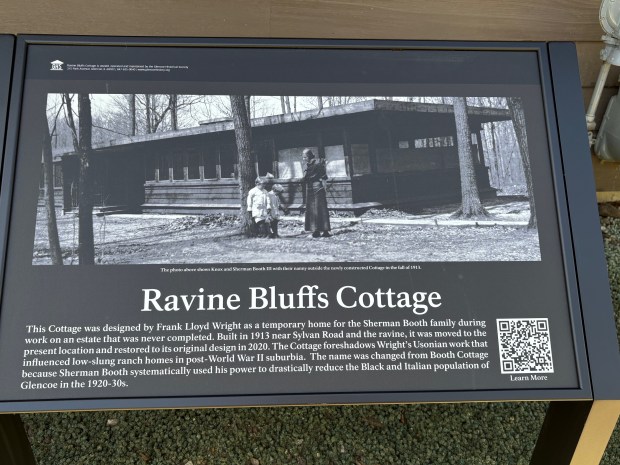Glencoe’s Ravine Bluffs Cottage, designed by Frank Lloyd Wright, has had a colorful past — being physically moved twice and last year being renamed because its namesake had an ugly racist history. However, its future remains unsettled as its owners scramble for funding to open the historic gem to the public.
Nearly five years after the Frank Lloyd Wright-designed structure was hoisted up and moved about a quarter mile away to a new location in Glencoe, it remains closed to the public. A restoration of the building’s exterior has been completed, but the interior needs work, and the Glencoe Historical Society, which owns it, is conducting a fundraising drive so the building can be opened to the public.
“We saved it, we set it up for future success,” GHS co-president Patrick Kaniff said. “All the hard work is done and now it is just a matter of… finishing out the interior.”
The fundraising drive represents the latest chapter for the building constructed in 1913 by the acclaimed architect Wright. It was set to be a temporary home for the family of Sherman Booth, his friend and attorney.
Last year, however, the historical society announced it would strip the name of Sherman Booth from the cottage upon the discovery that Booth led a racist scheme in the 1920s, intending to keep Blacks and Italians out of Glencoe.
After an initial relocation in 1917, the cottage remained at 239 Franklin Road in Glencoe and was owned by a series of people, according to historical society officials. It is one of 13 Wright-designed structures in Glencoe, which has the third-greatest number of examples of his work in Illinois, trailing only Chicago and Oak Park.
GHS labels the cottage as a “transition building” and one of the last Prairie-style structure designed by Wright.
“While this building is small and simple, it really exemplifies his genius,” said Scott Javore, a historical society board member, who is also an architect.
John Waters, the preservation programs director of the Chicago-based Frank Lloyd Wright Conservancy, described the building’s characteristics.
“It is low, it is very horizontal with banded windows and a flat roof,” Waters said. “The way the eaves extend out on both sides more than they do on the front emphasizing the horizontality, that has much more of a feel for Wright’s later Usonian work.”
In 2019, the future of the cottage was in doubt as its owners inched toward demolition. The razing of a Wright-designed structure sparked an outcry from preservationists. Eventually, a deal was struck where the cottage was donated to the Glencoe Historical Society, where it would be moved to a small piece of land owned by the Glencoe Park District at 301 Maple Hill Road. The historical society leases the land from the Park District at the nominal rate of $1 per year.
A throng of curiosity-seekers gawked on a July 2020 morning as the cottage was moved and placed at its new home. As part of the move, Kaniff said the historical society raised $350,000 to stabilize and move the cottage as well as for property site work, exterior preservation and attending to interior needs such as the HVAC system, plus plumbing and electrical upgrades.
Since then, the historical society has spent about $14,000 a year for insurance and maintenance, Kaniff added.

With the doors closed, the cottage received little public attention until last year, when it removed Booth’s name due to his racist activities.
With the building renamed the Ravine Bluffs Cottage, the historical society now wants to raise another $350,000 to complete an interior restoration. While other ideas have surfaced in the past to activate the space, the historical society envisions a three room museum-type building with explanation of Wright’s history, his work in Glencoe and Prairie School architecture, Kaniff said.
The specifics of the $350,000 goal include $100,000 for the interior restoration and the rest for an endowment providing maintenance and upkeep funding in perpetuity, according to Kaniff.
The historical society held a fundraiser in March launching the drive. So far, they have raised about $61,500 with about 80% of that coming from historical society board members.
However, Kaniff, who works professionally in facility management, acknowledged the historical society is encountering challenging in the latest fundraising drive.
He said that lasting effects of the coronavirus pandemic still resonate for any museum in 2025.
The historical society has applied for both private sector and state grants, but has found little success, he added.
“In this climate and with the amount of need for historic structures, it is very difficult to access grants,” he said.
Another issue is the limitations of the Park District lease.
Upon fears from neighbors about activity on the property when the move was initially contemplated, the cottage may only be used for the historical society’s business and office, museum use, meetings, and programs pursuant to and consistent with the GHS mission and operational policies only,” explained Park District spokeswoman Erin Classen.
She said public hours of operation are limited to 9 a.m. to 5 p.m., with up to six events per year not to go later than 10 p.m. As for other limitations, the cottage may get no more than 15 hours of public use per week, and any additional hours require Park District approval.
With those terms, the cottage cannot host events such as weddings.
“That really ties our hands in raising ongoing money,” Kaniff concedes.
Thus, the search for the funding continues with Kaniff saying the organization is exploring selling naming rights as part of an overall effort seeking donors from Glencoe and throughout the North Shore.
As the drive continues, Kaniff concedes there is some frustration about the situation within the historical society board regarding the entire situation.
“The sense of frustration is that 80% of the project is done,” he said. “It is just what is most public that is… not done.”
Kaniff did not hide there is a sense of urgency to get the interior work going.
“We have board members who have been working toward the goal of finishing the interior for years,” he said. “There is no deadline, but the public has increasingly said they would like to see the finished product as well.”
The historical society does not receive any local government funding, but the village is monitoring the situation.
“The GHS plan at the outset was to ensure that the cottage was first relocated, and then that the exterior be restored so that its appearance was attractive and fit in with the neighborhood. We recognize the challenges of fundraising and are eager to see the GHS’ plans for the future use of the cottage,” Village Manager Phil Kiraly wrote in an e-mail.
“It was always intended to be a much more passive space than their main campus in downtown Glencoe, and in fact, restrictions on its use were included in the agreement between the GHS and the Park District. The Village remains supportive of the GHS and looks forward to the opportunities for the cottage to support awareness of Glencoe’s unique architectural heritage.”
Village President Howard Roin spoke of the potential benefits of the cottage at the March fundraiser.
“It is not our asset but it is an asset to the village,” Roin said. “This could be one of our crown jewels.”




